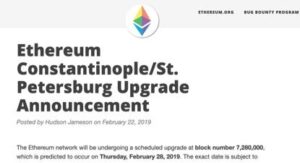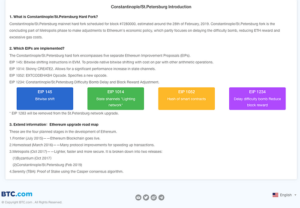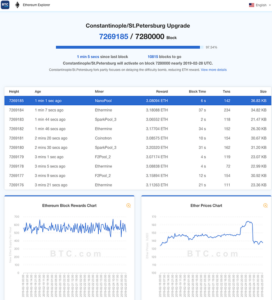Ethereum, the second largest cryptocurrency by market cap. Its upcoming upgrade, Constantinople/St. Petersburg will take place at block #7280000 block according to the official announcement.

This fork was scheduled in the first month of 2019. The Ethereum Core Developers and the Ethereum Security Community were made aware of the potential Constantinople-related issues identified by security researchers on January 15, 2019. Out of an abundance of caution, they delayed the planned Constantinople that would have occurred on the following day.
What is Constantinople and St. Petersburg?
Constantinople/St. Petersburg is simply the names given to the update of the Ethereum network. “The reason that this network upgrade has two names is that the original Constantinople network upgrade was postponed and two protocol upgrades will need to occur on the same block number to fix issues on various Ethereum test networks, such as Ropsten.” explained by the announcement.
Like the non-contentious updates that have come before (Homestead in 2016 and Byzantium in 2017), this hard fork will result in two chains with the old chain dying almost immediately. This new chain includes a handful of new Ethereum Improvement Proposal (EIP) implementations that are all intended to improve Ethereum. Constantinople contains 4 EIPs in total.
Which EIPs are implemented?
This fork will be released in two simultaneous parts. The Constantinople part will contain all four EIPs. On the second upgrade, EIP 1283 will be removed.

All of the EIPs in above pictures are part of a broader vision of ETH 2.0, which aims to improve the functionality of Ethereum in the long term. Besides, this fork will ease the transition from the current proof-of-work (PoW) to the energy-efficient proof-of-stake (PoS) consensus algorithm.
What does this fork mean and what you need to do?
If you’re merely an owner of ETH, you DO NOT need to do anything to prepare for this update.
If you are minder, or node operator, please visit the official blog and download the latest version of your Ethereum client. If you are contract owners, you may choose to examine the analysis of the potential vulnerability and check your contracts.
Block #7280000 will occur in approximately on Feb 28th. There are 10815 blocks to go. To help the concerned people to monitor the status and obtain the latest data, BTC.com developed Ethereum Constantinople/St. Petersburg monitor page. Miners can be aware of the rewards for each block, and the investor can observe the fluctuations in price.

